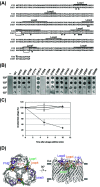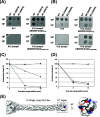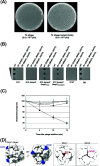Manipulating Interactions between T4 Phage Long Tail Fibers and Escherichia coli Receptors
- PMID: 33893116
- PMCID: PMC8315975
- DOI: 10.1128/AEM.00423-21
Manipulating Interactions between T4 Phage Long Tail Fibers and Escherichia coli Receptors
Abstract
Bacteriophages are the most abundant and diverse biological entities on Earth. Phages exhibit strict host specificity that is largely conferred by adsorption. However, the mechanism underlying this phage host specificity remains poorly understood. In this study, we examined the interaction between outer membrane protein C (OmpC), one of the Escherichia coli receptors, and the long tail fibers of bacteriophage T4. T4 phage uses OmpC of the K-12 strain, but not of the O157 strain, for adsorption, even though OmpCs from the two E. coli strains share 94% homology. We identified amino acids P177 and F182 in loop 4 of the K-12 OmpC as essential for T4 phage adsorption in the copresence of loops 1 and 5. Analyses of phage mutants capable of adsorbing to OmpC mutants demonstrated that amino acids at positions 937 and 942 of the gp37 protein, which is present in the distal tip (DT) region of the T4 long tail fibers, play an important role in adsorption. Furthermore, we created a T4 phage mutant library with artificial modifications in the DT region and isolated and characterized multiple phage mutants capable of adsorbing to OmpC of the O157 strain or lipopolysaccharide of the K-12 strain. These results shed light on the mechanism underlying the phage host specificity mediated by gp37 and OmpC and may be useful in the development of phage therapy via artificial modifications of the DT region of T4 phage. IMPORTANCE Understanding the host specificity of phages will lead to the development of phage therapy. The interaction between outer membrane protein C (OmpC), one of the Escherichia coli receptors, and the gp37 protein present in the distal tip (DT) region of the long tail fibers of T4 bacteriophages largely determines their host specificity. Here, we elucidated the amino acid residues important for the interaction between gp37 and OmpC. This result suggests that the shapes of both proteins at the binding interface play important roles in their interactions, which are likely mediated by multiple residues of both binding partners. Additionally, we successfully isolated multiple phage mutants capable of adsorbing to a variety of E. coli receptors using a mutant T4 phage library with artificial modifications in the DT region, providing a foundation for the alteration of the host specificity.
Keywords: Escherichia coli; bacteriophage therapy; bacteriophages.
Figures







Similar articles
-
Characterization of the interactions between Escherichia coli receptors, LPS and OmpC, and bacteriophage T4 long tail fibers.Microbiologyopen. 2016 Dec;5(6):1003-1015. doi: 10.1002/mbo3.384. Epub 2016 Jun 6. Microbiologyopen. 2016. PMID: 27273222 Free PMC article.
-
LamB, OmpC, and the Core Lipopolysaccharide of Escherichia coli K-12 Function as Receptors of Bacteriophage Bp7.J Virol. 2020 Jun 1;94(12):e00325-20. doi: 10.1128/JVI.00325-20. Print 2020 Jun 1. J Virol. 2020. PMID: 32238583 Free PMC article.
-
Characterization of the distal tail fiber locus and determination of the receptor for phage AR1, which specifically infects Escherichia coli O157:H7.J Bacteriol. 2000 Nov;182(21):5962-8. doi: 10.1128/JB.182.21.5962-5968.2000. J Bacteriol. 2000. PMID: 11029414 Free PMC article.
-
[Bacteriophage T4: molecular aspects of bacterial cell infection and the role of capsid proteins].Postepy Hig Med Dosw (Online). 2010 May 25;64:251-61. Postepy Hig Med Dosw (Online). 2010. PMID: 20498502 Review. Polish.
-
[Escherichia coli phage receptors. Minor porins and proteins participating in the specific transport as phage receptors].Mol Gen Mikrobiol Virusol. 1989 Dec;(12):3-12. Mol Gen Mikrobiol Virusol. 1989. PMID: 2561376 Review. Russian.
Cited by
-
Characterization and the host specificity of Pet-CM3-4, a new phage infecting Cronobacter and Enterobacter strains.Virus Res. 2023 Jan 15;324:199025. doi: 10.1016/j.virusres.2022.199025. Epub 2022 Dec 14. Virus Res. 2023. PMID: 36528171 Free PMC article.
-
A Polyvalent Broad-Spectrum Escherichia Phage Tequatrovirus EP01 Capable of Controlling Salmonella and Escherichia coli Contamination in Foods.Viruses. 2022 Jan 29;14(2):286. doi: 10.3390/v14020286. Viruses. 2022. PMID: 35215879 Free PMC article.
-
An OmpW-dependent T4-like phage infects Serratia sp. ATCC 39006.Microb Genom. 2023 Mar;9(3):mgen000968. doi: 10.1099/mgen.0.000968. Microb Genom. 2023. PMID: 36995210 Free PMC article.
-
Engineering Phages to Fight Multidrug-Resistant Bacteria.Chem Rev. 2025 Jan 22;125(2):933-971. doi: 10.1021/acs.chemrev.4c00681. Epub 2024 Dec 16. Chem Rev. 2025. PMID: 39680919 Free PMC article. Review.
-
Engineering bacteriophages for enhanced host range and efficacy: insights from bacteriophage-bacteria interactions.Front Microbiol. 2023 May 31;14:1172635. doi: 10.3389/fmicb.2023.1172635. eCollection 2023. Front Microbiol. 2023. PMID: 37323893 Free PMC article. Review.
References
-
- Goldberg E, Grinius L, Letellier L. 1994. Recognition, attachment, and infection, p 347–356. In Karam JD, Drake JW, Kreuzer KN, Mosig G, Hall DH, Eisering FA, Black LW, Spicer EK, Kutter E, Carlson K, Miller ES (ed), Molecular biology of bacteriophage T4, vol 1. ASM Press, Washington, DC.
Publication types
MeSH terms
Substances
LinkOut - more resources
Full Text Sources
Other Literature Sources
Molecular Biology Databases

